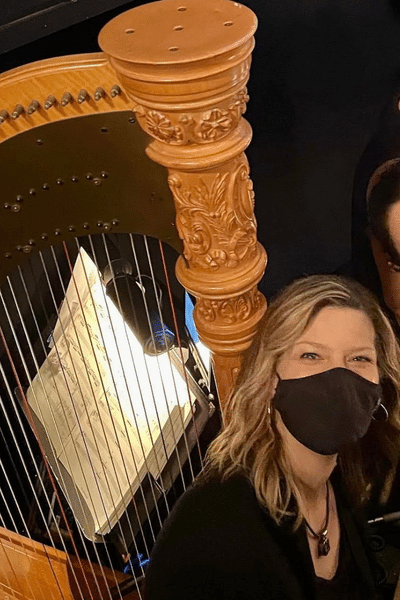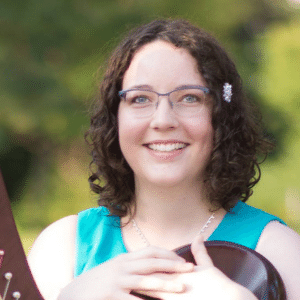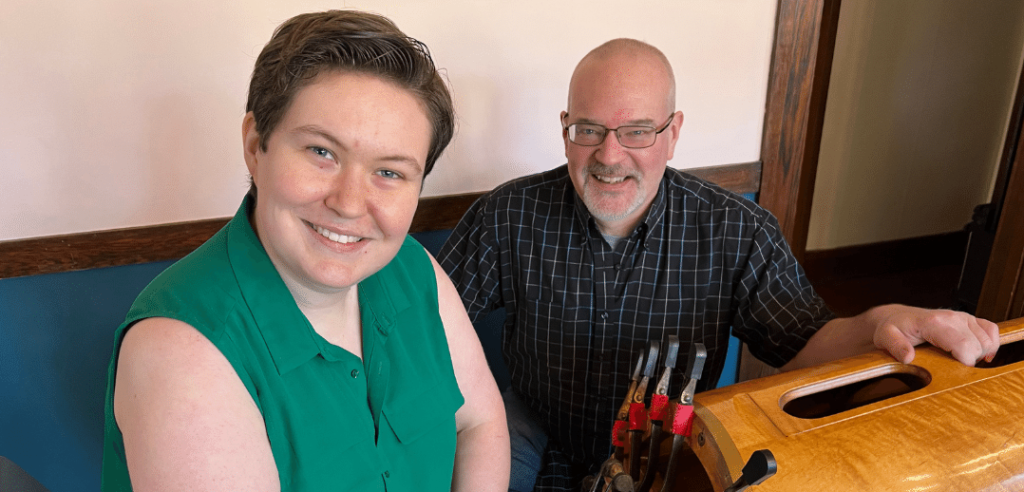
shares her view from the pit of
Paradise Square during its recent run on
Broadway.
In the final installment of our Job Shadow series, we’re pulling back the curtain on the musical side of show business. Kirsten Agresta Copely has been on the Broadway scene for a long time. She started as a sub on Beauty and the Beast right after moving to New York City in 1996. Since then, she has subbed on 11 other Broadway shows. Recent highlights include Flying Over Sunset at Lincoln Center, Carousel, and Cinderella. She has opened three shows performing regularly as the original harpist: The Pirate Queen, Wonderland (playing the Keyboard 3 part), and Paradise Square. With her 26 years of experience, Copely offers us a look at Broadway musicals from backstage.
Name one or two of your favorite moments in your most recent show, Paradise Square. Why are they special?
I was honored to have the composer, arranger, and musical director Jason Howland create this harp score especially for me. There was a beautiful solo moment in “Someone To Love” where I accompanied the singers alone, and another at the top of “Breathe Easy.” Aside from those, the moment that gave me chills every single show was Tony Award winner Joaquina Kalukango holding the final note in “Let It Burn” with tears streaming down her face.
How does playing in an open pit impact your performance?
I love playing in theaters like Barrymore [Theatre] that have an open pit, because it allows you to see the audience’s reactions and interact with them from time to time. People love looking over the railing and seeing the harp! It also gives a much closer experience to the actors whom you can sometimes see at various moments during the show.
The downside is that the dust and dirt from dancing scenes floats down onto the instrument. I use a soft cloth to clean the sounding board before each show.
What does your weekly schedule look like as a Broadway harpist?
[The standard schedule is] eight shows a week with Monday being a “dark” day [or day off]. There are matinee and evening shows on Wednesdays and Saturdays.
What does the process of rehearsing, doing preview concerts, and playing shows look like?
There are usually a few days of rehearsal before heading into the theater for seating, sound check, and tech rehearsals with the cast. Then preview performances [run] for a few weeks before opening night. The music can be edited during this time—sometimes measures are cut, keys are changed, etc. By opening night, the book is usually “frozen,” meaning no more changes will occur.
How is subbing different from playing a show regularly? What do you have to do to jump in and adapt to the music that others have already been making together?
Subbing is much more difficult than having your own show. You are required to watch the book from the pit twice, and must be approved by the conductor after your first show. Nowadays, there are conductor videos that the principal chair will send to subs so they can practice the show along with it. It’s important to try to play the charts as stylistically close to the principal harpist as possible for continuity.
How long does a show run?
Shows are either open-ended (meaning they run for as long as possible) or have a limited run (they have a fixed closing date).
What keeps it interesting?
I’ve had smoke machines that blow right into my face, fake snow that sprinkles on the harp, and occasionally, a rogue prop that lands in the pit. Basically, you have to be ready for it all and stay cool as a cucumber in order to land your cues. Sometimes we write or draw silly things in the charts to make our subs (and ourselves) laugh. There are almost always inside jokes based on lyrics, lines, etc. On Paradise Square, one of the musicians made photo copies of our dogs and hid them at various spots in our music—we kept turning pages and seeing our pups appear! We pasted them to our folders for the rest of the run.
What do you love most about playing on Broadway?
I love the camaraderie amongst the musicians and often members of the cast. The colleagues you perform with become your show family, so a positive attitude (and some shared chocolate at intermission) goes a long way.
What advice do you have for harpists considering a career on Broadway?
Connect with a seasoned professional and offer to meet for coffee or lunch, or take a sample lesson from them. Forging relationships is the best way to integrate into the industry, and you never know if they might need a sub on their next show! •
If you’re interested in learning more about Broadway, check out our article in the July/August 2018 issue of Harp Column, “Give My Regards to Broadway,” featuring five harpists who played shows that year.
Job Shadow
This is the last of our year-long Job Shadow article series giving readers a glimpse of creative careers forged by harpists—careers for the mechanically inclined who repair and regulate harps; trend-setters making waves on social media; harpist-composers adding to the instrument’s repertoire; adventure-seekers taking their harp to the high seas on cruise ships; collaborative harpists able to cross genres to lay down recorded tracks with other artists; and harpists who make music from the pits of Broadway. These are only a few of the ways harpists carved their own careers. What musical niche will you find to fill?














